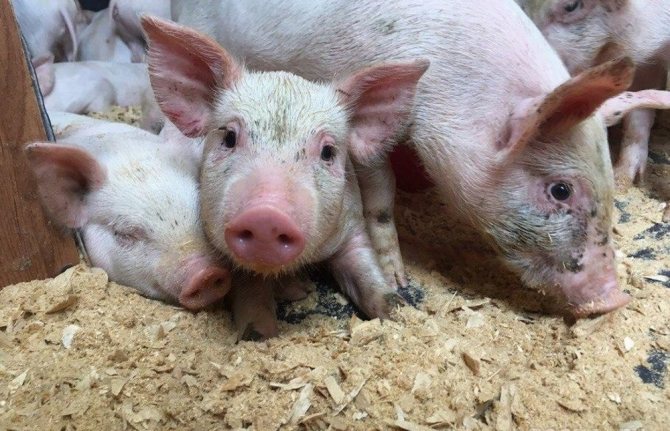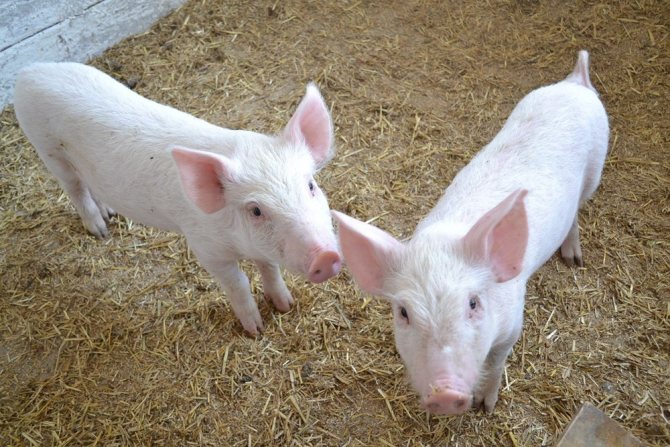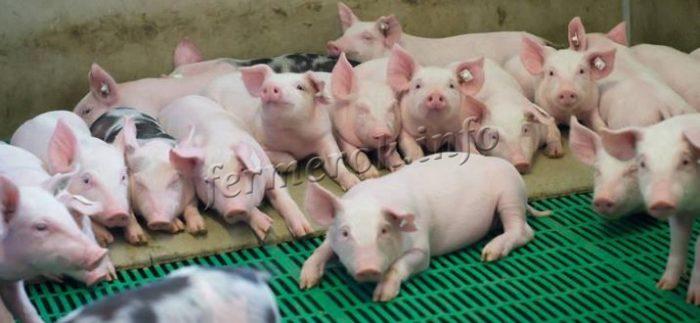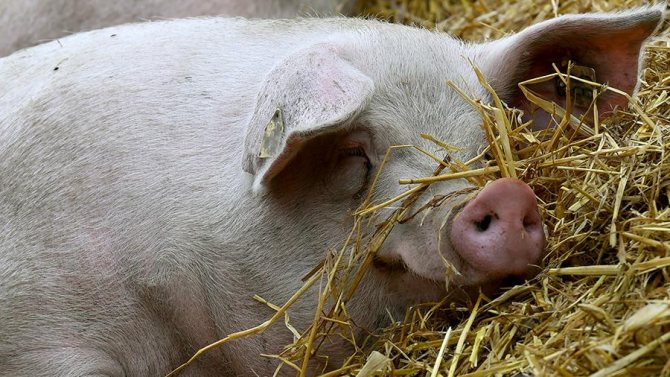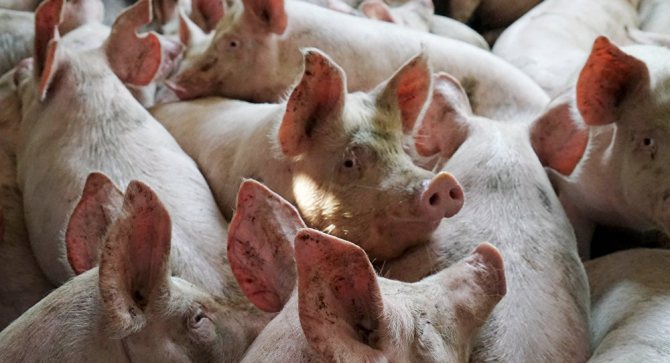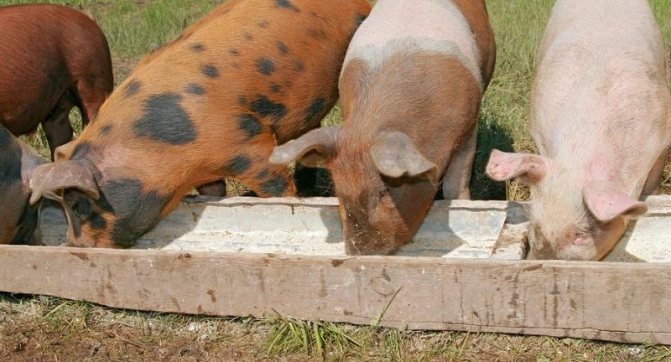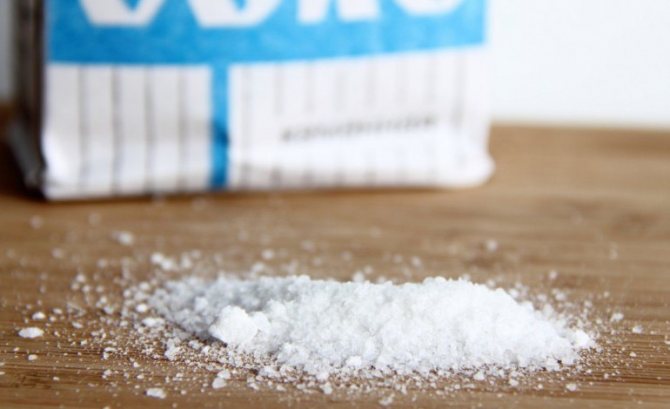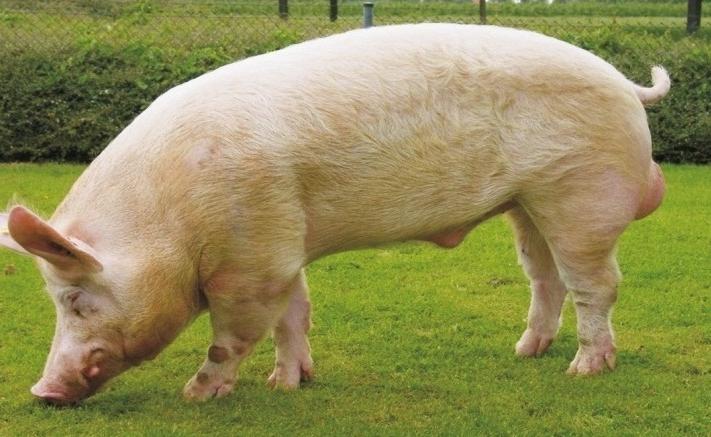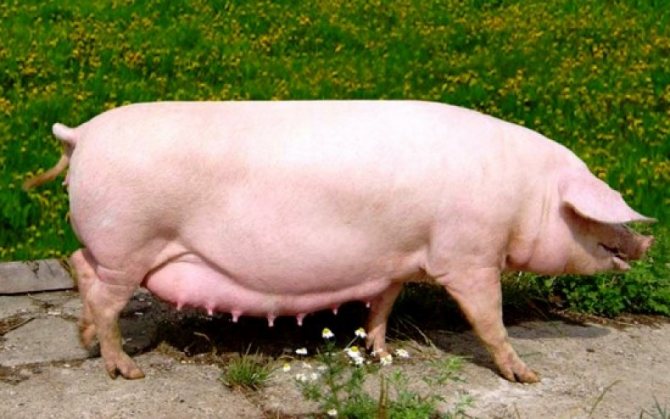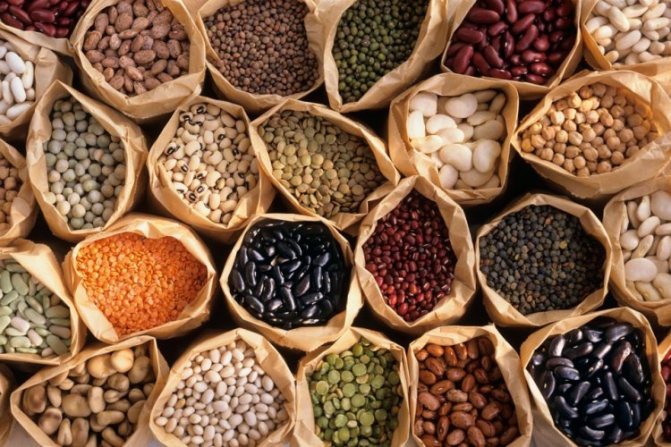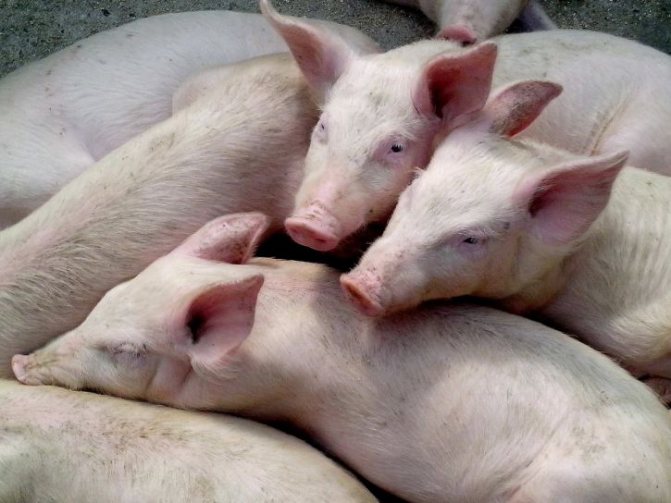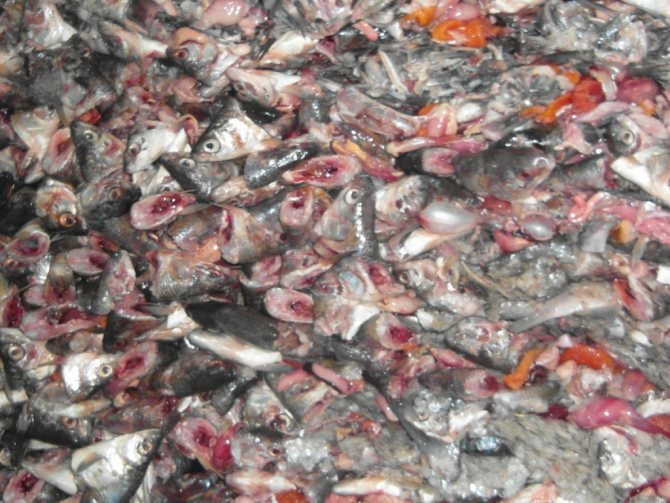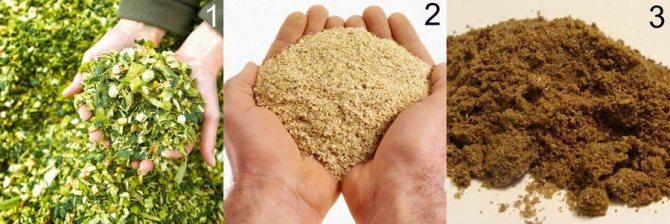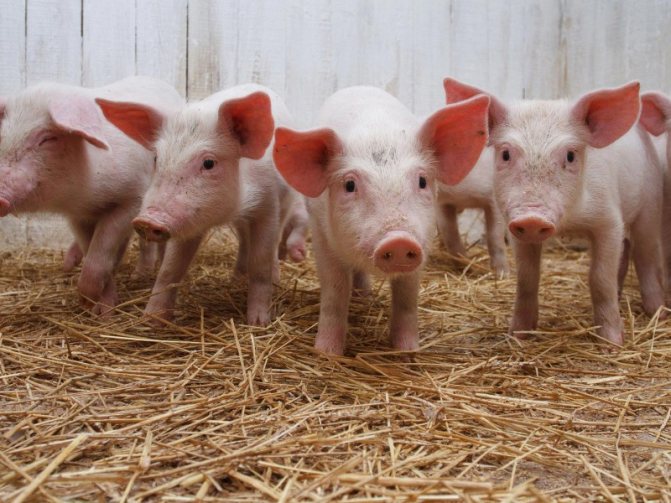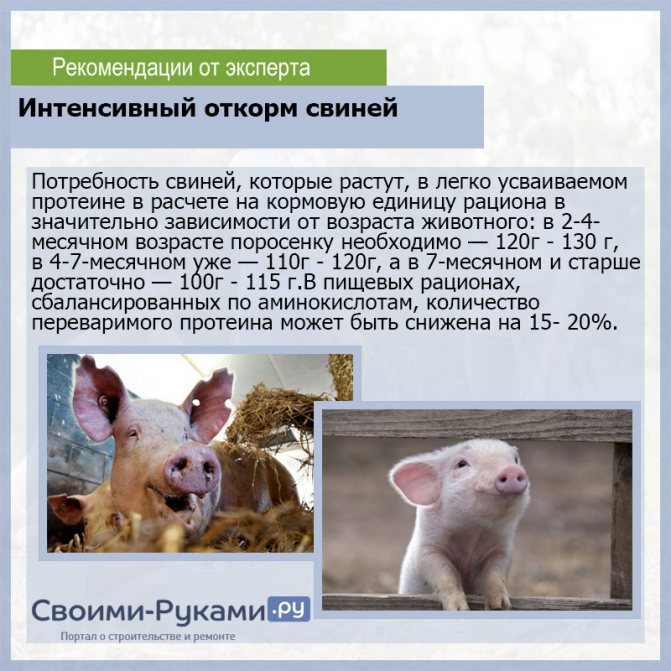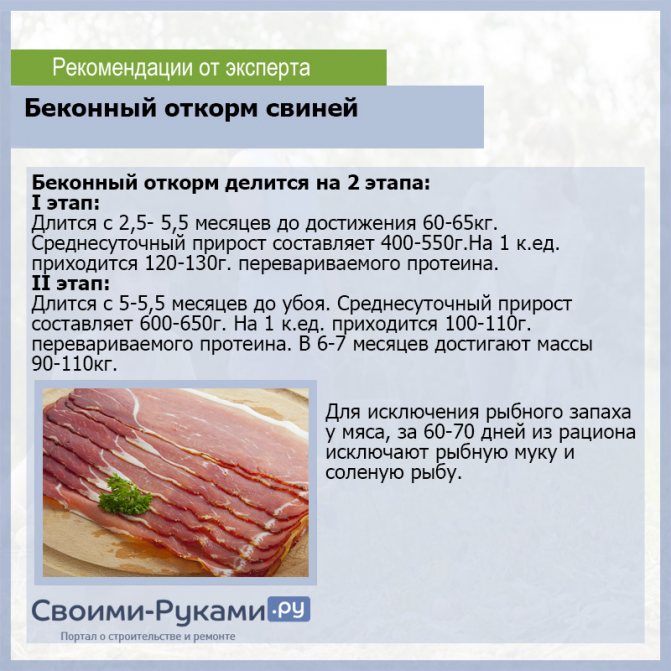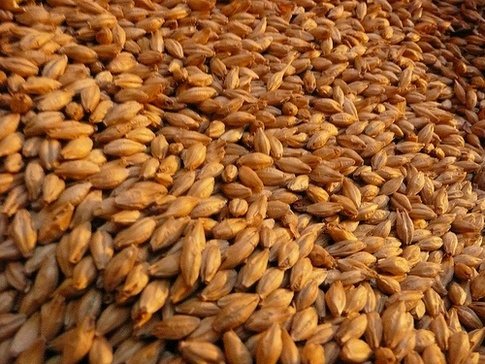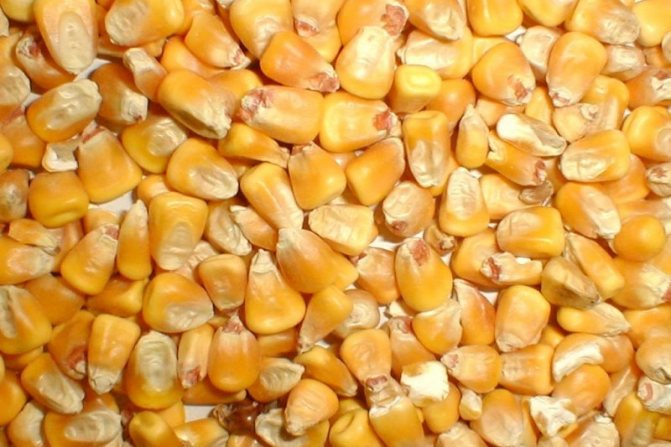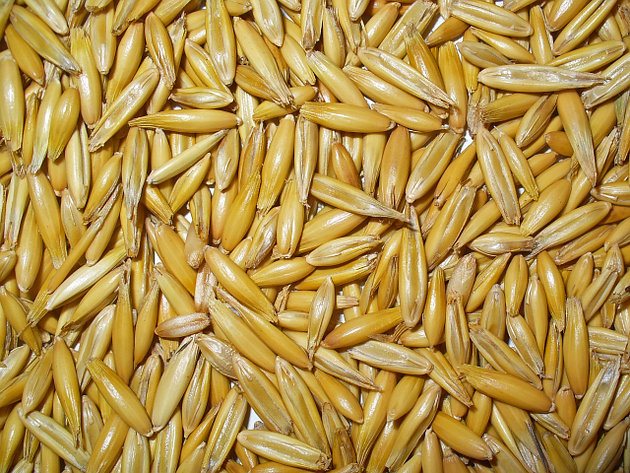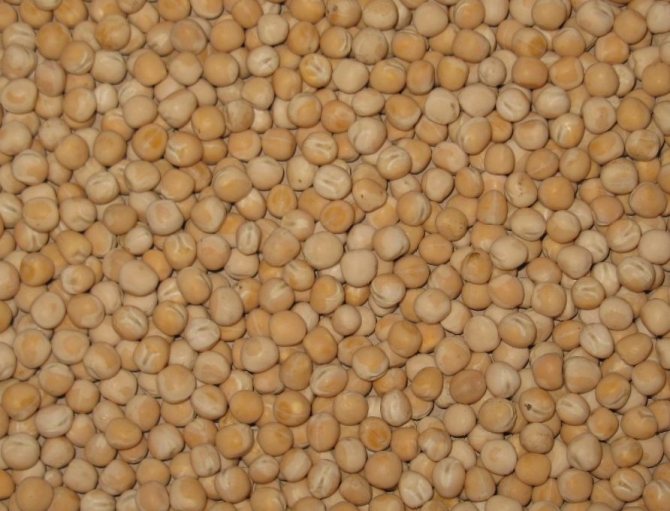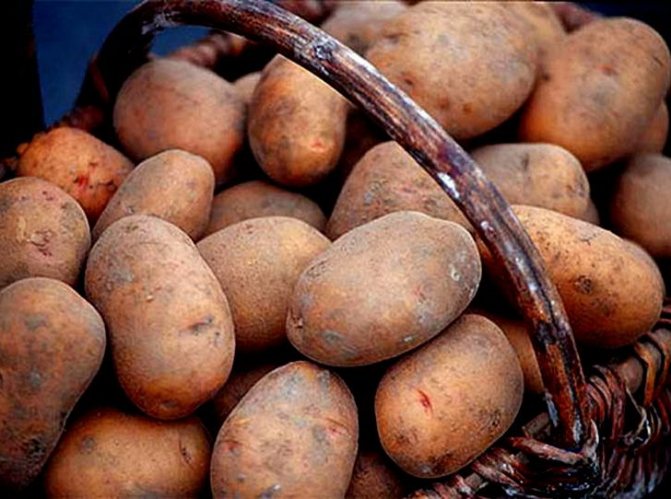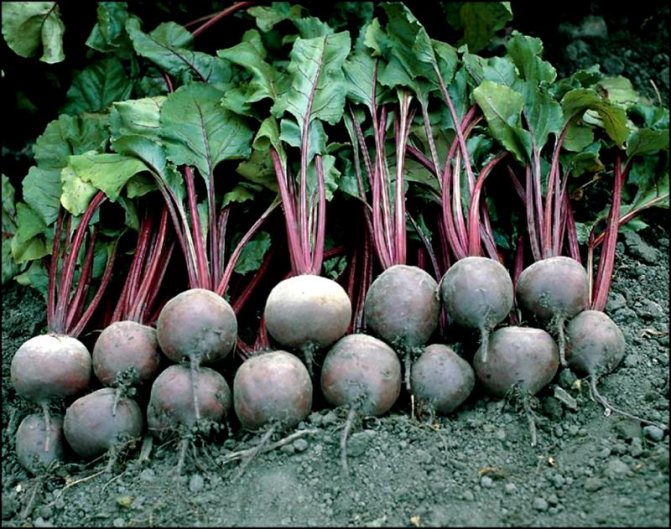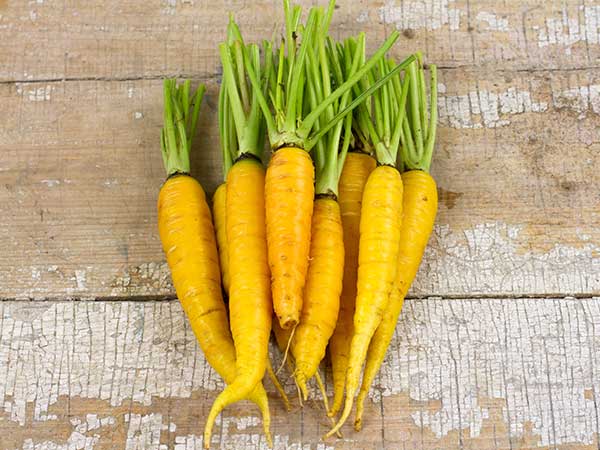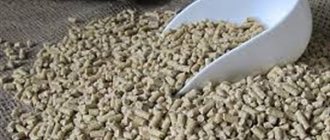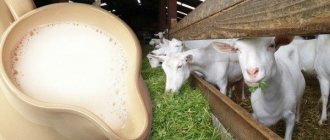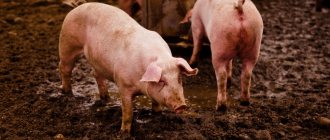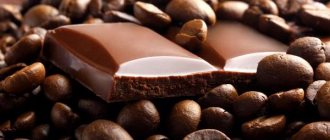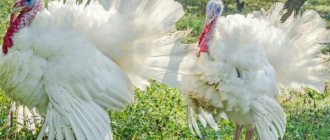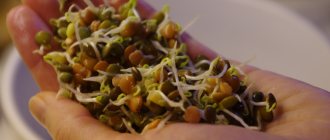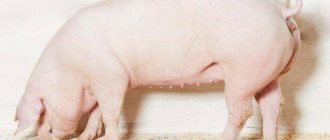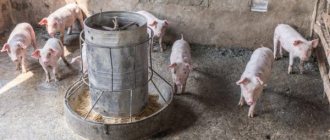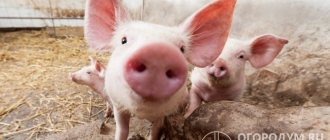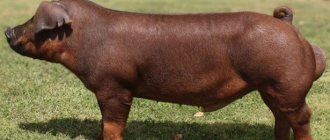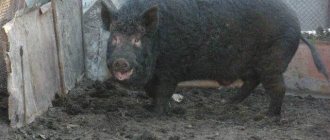Livestock »Pigs
0
1293
Article rating
Today, the quality of products sold in stores and on the market is difficult to determine without special research. More and more people are thinking about raising livestock on their own. The most promising and economical in terms of breeding and keeping are pigs. Their meat is by far the most demanded. Fattening pigs for meat to large sizes is not an easy task and requires some knowledge and skills from the farmer.
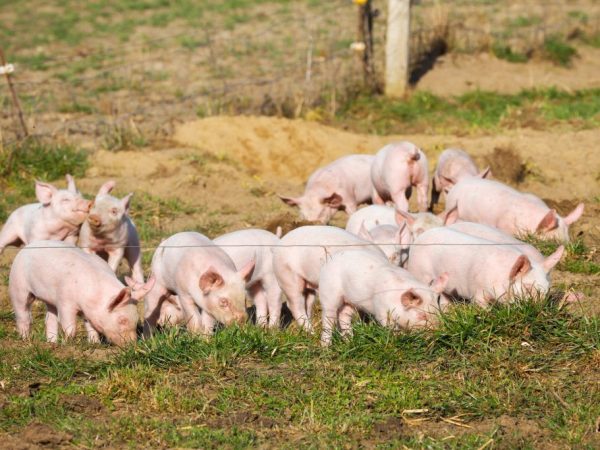
Feeding pigs at home
What pigs eat
Pigs are omnivorous mammals. In the wild, they eat whatever they can find:
- roots;
- mushrooms;
- grass;
- acorns;
- insects and their larvae;
- bird eggs and chicks;
- carrion.
The wild boars will not refuse to come to the potato field and plow it conscientiously, having eaten the entire crop. Domestic pigs in this respect are no different from wild relatives. At home, no one will feed pigs with “forest delicacies”. The exception is acorns. But even here, pigs leading a semi-wild lifestyle are more often fattened with acorns. This method of pig breeding is practiced in Hungary.
Usually, pigs are fed at home with grain concentrates, root crops and kitchen waste. Pigs rarely get meat. Controlled feeding of pigs allows you to get products of different quality:
- lean pork with hard lard;
- fatty meat and soft, greasy lard;
- lard with layers of meat.
The pig diet in this case is strictly rationed and regulated. Such animals cannot be sent to free grazing in the forests.
What can not be fed to pigs
Contrary to the saying "the pig will eat everything", you can not feed the piglets with all kinds of products. The principles for identifying feed that are not suitable for pigs are the same as for other livestock. When giving fresh grass, you need to make sure that no poisonous plants get there. There are quite a few such plants and there is no point in listing them, since the “herbaria” differ depending on the region. Each owner will have to independently study the flora near their farm.
Other feeds for pigs are "standard": cereals, roots and animal feed. Do not give to pigs:
- compound feed with a moldy smell;
- "Burning" grain;
- rotten roots;
- sprouted potatoes.
Such feed will lead to animal poisoning.
What is the basis of the diet
Feed - how much you need to quickly gain weight
The types of feed are subdivided according to the nutritional value and the main components:
- concentrates, or energy - cereals, cereals;
- proteinaceous - legumes, meal, flour;
- rough - vegetables, hay, bran;
- animals - by-products of dairy and meat production (whey, blood and bone meal).
You can find out about the pig feeding table here.
You can prepare your own pig feed at home.
Cereals can be prepared by boiling, steaming, and yeast methods. This recipe is often used:
- For 1 kg of grain, 2 liters of hot water are taken. The food is poured with water and mixed, covered with burlap to obtain a steamed product. In 5 hours it is ready.
Silage is considered to be quite valuable from juicy feed. Homemade recipes:
- 60% sugar beet
- 30% corn on the cob,
- 10% carrots.
- 45% steamed potatoes,
- 50% vegetables
- 5% grain waste.
The silage mass must be crushed and placed in prepared bins or pits. The mass is well rammed and covered. To reduce moisture, you can add about 7% peas. For 100 kg of silage, 400 table salt is added.
Compound feed
They combine the components of various types of feed. Producers produce two types of compound feed for piglets and adult pigs:
PC provides good nutrition for pigs that does not require additional additives. According to GOST, the PC includes from 6 to 12 components.
CC is used as a supplement to other feed, contains proteins, vitamins and minerals.
At home, you can prepare nutritious compound feed yourself according to the following composition:
- barley - 0.4 kg,
- oats - 0.3 kg
- alfalfa flour - 0.16 kg;
- meat and bone meal - 0.12 kg;
- sunflower cake - 80 g;
- chalk - 20 g;
- salt - 10 g.
Proper organic nutrition
Intensive raising of pigs is ineffective without the use of minerals, dietary supplements and vitamins. For this purpose, special mixtures of active substances are produced - premixes with organic trace elements and amino acids. Plant proteins are extracted by enzymatic hydrolysis and combined with trace elements. Such organic complexes are called bioplexes, they are better absorbed than minerals in the composition of feed.
Alltech bioplex made in Great Britain includes:
- iron 50,000 mg / kg,
- zinc - 20,000 mg / kg,
- manganese - 15000 mg / kg,
- copper - 5000 mg / kg,
- selenium - 200 mg / kg.
The use of bioplexes is a promising method for enriching and balancing the diet of piglets.
Additives for fast fattening pigs for meat
The intensive type of feeding of young stock involves the use of growth stimulants. Feed additives with vitamin, mineral, bioactive, antibiotic properties are used. Supplements stimulate pig digestion, increase live weight gain.
In the diet of pigs, additives can be found:
- Amylosubtilin GZH, which stimulates fat deposits in pigs;
- Etonium increases the growth, and the quality composition of meat,
- Betazine - increases the growth rate, reduces feed consumption;
- Azobacterin satisfies the portability in nitrogen and vitamin B 12;
- Monosodium glutamate stimulates the appetite of pigs, improves the taste of meat;
Organic acids (succinic, citric and glutamic) also have a positive effect on stimulating growth.
To stimulate growth, antibiotics grisin, hygromycin, biovit, icin, flavomycin and others are also used.
Antibiotics and stimulant medications must be used as directed.
Types of pig feeding
Pigs are fed, wishing to get 3 types of products:
- meat;
- fat;
- bacon / lard with meat streaks.
It is impossible to get everything from the same pig, so you need to choose how to feed the pig in order to get one or another product.
No matter how ridiculous it may sound, the types of feed are the same for any direction of cultivation. Their ratio and feeding time vary. There is no miracle food that is better to feed pigs so that they gain weight quickly. There is the right balance between protein, fat, carbohydrates, amino acids and minerals. Without lysine, it will be very difficult to fatten a pig for meat, and without vitamins, not a single pig can be raised. At the same time, feeds differ in efficiency and the result obtained. Therefore, when feeding, you must also take into account the properties of each type of feed.
Ventilation of the room
The walls of a pigsty, in which it is planned to raise pigs for meat or sell live weight, should be made of non-moisture-consuming and heat-insulating materials that will keep warm in winter.
- wood;
- brick;
- porous gas blocks;
- cinder blocks;
- rubble stone.
The inside of the wall can be plastered and whitewashed or planked. A suitable microclimatic environment for keeping the pigs must be maintained in the pigsty. The attic must be insulated, and the floors can be filled with concrete or assembled from planks. In the outer walls, we need manholes with dimensions of 70x70 cm, through which animals can get to the outdoor area for walking.
In the pigsty, you need to equip a ventilation system that will remove the processed air from the room, and instead drive in fresh air from the street.
Keeping pigs on a small scale is possible with a home-made ventilation system, and for breeding on a larger scale, industrial equipment will be required.
How to feed pigs properly
The build-up of muscle or sebum mass is influenced by the protein ratio in the diet. The protein ratio is calculated using the formula:
PO - protein ratio;
BEV - nitrogen-free extractive substances.
Important! Vegetable fats are multiplied by a factor of 2.25; for animal fats, the factor is 2.5.
Pig gets digestible protein from feed containing nitrogen. A narrow protein ratio is a ratio of 1: 6, that is, on the right side of the formula, the result should be 6 or less. With this protein ratio, the pig builds up muscle mass. The fat yield is small, the product is solid.
With a wide protein ratio: 1: 8-1: 10, the pig is salted, gaining a small amount of meat. The fat is soft, smearing. The quality of such lard is considered low.
The feed itself also affects the quality of pork. They are all divided into 3 groups:
- improving;
- deteriorating fat;
- degrading meat.
When feeding the second group, the fat turns out to be watery, soft, smeared and tasteless. When feeding the third group, the meat acquires an unpleasant aftertaste and a watery consistency.
Improving feeds include:
- peas;
- wheat;
- rye;
- barley;
- carrot;
- beets;
- buttermilk;
- return;
- meat flour.
Table pumpkin is not very suitable as feed for pigs. Therefore, young animals raised for meat are usually not fed with it. The production of fodder pumpkin is underdeveloped. But research has shown that feed pumpkin - one of the best feed for pigs - is not available only during fattening. The breeding stock was fed up to 19 kg per head per day. Feeding fodder pumpkin in the amount of 30% of the diet led to an increase in daily weight gain in half-year-old gilts to 900 g.
But feed pumpkin is more suitable for fattening pigs for bacon and lard. When feeding raw and boiled pumpkin in an amount of 15-20 kg per day, gains were obtained from 500 to 800 g.
Important! It is better to feed meat-fed pigs in very limited quantities: there are a lot of sugars in it, which will be used for the deposition of fat.
Group of feeds that deteriorate fat:
- soy;
- corn;
- bran;
- oats;
- cake;
- potatoes;
- fish flour.
Lard turns out to be worse in taste, soft and smearing. It is better to feed these products in the first stage of fattening.
Feed that degrades the quality of meat includes waste from the production of wine, alcohol and sugar:
- pulp;
- pulp;
- bard.
The meat takes on an unpleasant smell and taste.
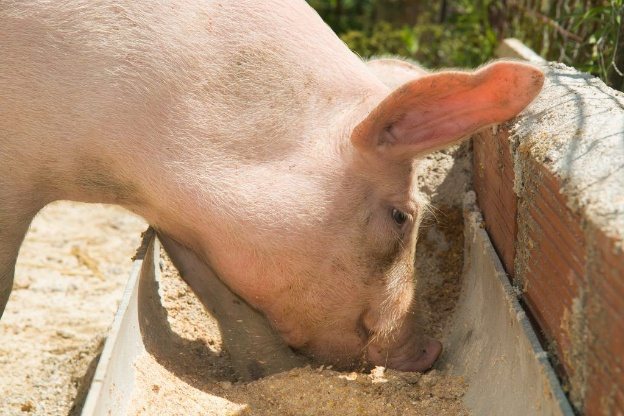

Compliance with the regime
All animals are conservatives who do not like changes and violations of the established regime. Animals very quickly get used to the established daily routine. Violation of the regime causes anxiety and stress. Even cleaning the stables is better at the same time, and haphazard feeding impairs the digestibility of the feed and can lead to gastrointestinal diseases.
Therefore, it is better to feed the pigs at the same time. “Knowing” the schedule, the pig will wait for feed, and the stomach will start producing gastric juice in advance. The frequency of feeding is set by the owner. The minimum amount is 2 times a day. If there is someone to look after, then they are fed three times a day.In the case of fattening pigs, access to feed is often not restricted at all. But in this case, dry feed is usually given.
It is convenient for a private owner with a large livestock to use bunker feeders, where dry concentrates or compound feed are poured. The feeder prevents pigs from throwing feed on the floor and does not restrict access to feed throughout the day.
Although the pig is omnivorous, whole grains are very poorly absorbed by it. Her teeth aren't really meant to be chewed for long. The animal swallows food in large pieces. Because of this, whole grains pass through the intestines intact. It is better to give cereal to pigs in a chopped form. For better assimilation of food by animals, cereals are cooked. In winter, warm porridge also helps the piglets to keep warm.
Separate feeding of piglets
Up to a month, the main food of a piglet is mother's milk, although they start trying "adult" feed after 10 days. Piglets are taught to vitamin and mineral feeding from the 5th day of life. After 7 days, a little fried cereal is given. 10 days after birth, piglets are fed with fresh cow's milk or milk replacer. From the same time, concentrates are fed.
Important! By 2 months, the amount of concentrates should increase from 25 g per day to 0.8 kg.
From a month to two, piglets can feed with the sow, and she will not drive them away from the feed much. But it is better to separate the sow while the piglets are feeding milk. Also, the pig still allows the piglets to suckle themselves, although from a month it is advisable to feed the brood with skim milk and milk porridge separately from the mother.
From 2 months, the sow believes that the cubs are able to get food on their own, and begins to aggressively drive them away from the feed, not allowing them to reach the teats. From this point on, the piglets are separated from the sow and fed separately. Dairy products must be included in the diet of a piglet up to 3 months old.
The division of the diet according to the type of feeding is done from 3-4 months of age of piglets. At this time, the pigs are put to fattening. The diet is calculated based on the type of desired product.


Maintaining the appetite of pigs
In order for the animals to eat better and, accordingly, gain weight faster, feed should be prepared. Usually, such additional measures are taken when fattening pigs. But in some situations, these techniques can be useful when raising animals for meat. Before feeding, for example, cereals, they are subjected to a malting procedure. It consists in pre-soaking concentrated feed with hot water (85-90 degrees) for about 4 hours. In this case, about 1.5-2 liters of liquid are taken per kilogram of grain.
In the event that the pigs do not eat the mash, the leftovers can be poured with pre-prepared oat milk. The pigs like this improved feed much more than usual.
To prepare such milk, one kilogram of oatmeal is poured with boiled cooled water and mixed. The chatterbox should stand in a warm room for about three hours.
Fattening pigs at home for meat
In theoretical pig breeding, to obtain lean pork, you need to take elite meat breeds: Landrace, Duroc, Pietrain. In practice, everything is more complicated. The breeds listed do indeed produce quality meat with a minimum of fat. But because of the thin body fat, these pigs are very demanding on temperature. It is difficult for a private trader to maintain a narrow temperature range year-round, therefore, in practice, they use a large white breed of pigs. This breed is officially considered to be meat and greasy, but it has lines of the meat direction. When crossing large white with meat breeds, the hybrids inherit good climate resistance. The quality and yield of meat per carcass in hybrid pigs is also increasing.
Piglets are put on meat feeding from 3-4 months. Finish feeding when the piglet reaches 100-120 kg. At the beginning of fattening at 3 months and daily weight gain of 550 g in 6 months, a pig can be grown up to 120 kg. With the meat version of feeding, it will not be possible to fatten pigs as quickly as with lard, since meat grows more slowly, although it is heavier than fat.
When feeding for meat per 100 kg of piglets, 4.2-4.8 feed is required. units in the first period of fattening and 3.5-4.2 feed. units in the second. In the first period, you need 90-100 g of digestible protein per feed. units, in the second - 85-90 g.
The average daily weight gain can be increased or decreased. For rapid growth, pigs need to be fed correctly, that is, to give food, in the dry matter of which there will be as much energy and as little fiber as possible. When fattening meat, the optimal content of fiber in dry matter is not more than 6%.
Pig Feeding Rations
The basic principle when feeding pigs for meat: in the first period, they give more protein feed, in the second - carbohydrate. There are 3 types of rations for winter feeding. They differ in the presence or absence of potatoes and root crops in the feed.


The feed is indicated as a percentage of the feed unit requirement.
In this case, concentrates mean:
- corn;
- peas;
- barley;
- wheat;
- wheat bran;
- compound feed (2-3 kg per day);
- meal: soybean, linseed, sunflower.
In the first half, you can feed any concentrates, but a month before slaughter, you need to exclude those that worsen the quality of pork.
The category of juicy feed includes:
- silage;
- beet;
- potatoes;
- feed pumpkin;
- kale;
- fodder beet;
- carrot.
Cabbage has the ability to stimulate the secretion of gastric juice. When feeding large quantities of cabbage, the stomachs of animals swell. Root crops and vegetables are fed in the amount of 3-5 kg per day. Silage yields 1-1.5 kg. Since silage is a fermentation product, you shouldn't get carried away with its quantity either.
Pigs are fed from animal products:
- return (1-3 l);
- buttermilk (1-3 l);
- meat and meat and bone meal;
- blood meal;
- low-fat minced fish and fish meal (20-40 g).
Herbal flour made from leguminous plants is given 200-300 g per day. Before feeding, flour should be soaked in cold water. It is often sold in tightly compressed granules. Swollen in the stomach, flour can clog the intestines.
In the summer, instead of grass meal, legumes of 2-4 kg per day are included in the diet. Mineral supplements must be mixed at any time of the year.
Important! Salt is put strictly according to the norm, since pigs are prone to salt poisoning.
Vitamin-mineral premixes are put at 10 g per 1 kg of dry matter of feed. If necessary, balance the ratio of protein and carbohydrates with the help of protein-vitamin and protein-vitamin-mineral supplements. Lysine deficiency in the diet is replenished with lysine feed concentrate. The requirement of pigs for this amino acid is 5-10 g per day.
Pigs are fed for meat for about 6 months with a daily weight gain of 550 g. A larger weight gain usually means that the pig has begun to grow salted.
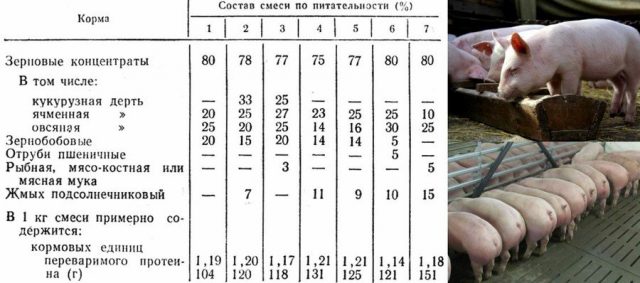

Final feeding period
Before slaughter, the pig must gain at least 100 kg of live weight. At the second stage, it is undesirable to feed products from those groups that worsen the quality of pork. It is better to refuse fish products immediately after the start of the second feeding period, replacing them with meat flour or dairy products. Also, at this stage, it is better not to give feed that degrades the quality of the fat. A month before slaughter, you need to stop giving feed that degrades the quality of meat.
Feed used
Regardless of the type of feeding, the ration of pigs should be varied in order to replenish the animal's body with all possible vitamins and nutrients. Next, we will talk about the types of food and the function of each of them.
Dry food
Among dry feeds for pigs, cereals are in the greatest demand.The reason for this is their richness in fiber, protein and carbohydrates, which play a huge role in increasing body weight and maintaining its health.
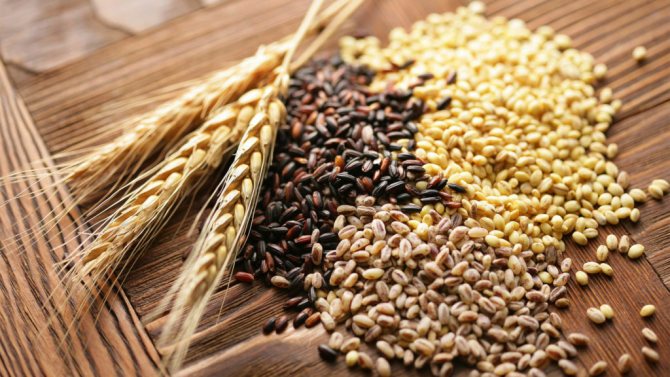

Among dry feed for pigs, cereals are most common.
Table 1. Types of cereals
| Cereal | Beneficial features |
Barley | It is an integral part of many diets due to its excellent digestibility by the pig's stomach (up to 90%). In addition to its health benefits, it improves the quality of the resulting meat or lard. It is added to the food of pigs of all ages. Its percentage in the daily diet ranges from 60 to 70% (excluding periods of feeding exclusively on concentrates) |
Corn | The main advantage of corn cobs is that they are rich in carbohydrates and fats (which are even higher than in barley). At the same time, corn is inferior in all other parameters - it contains almost no protein and other nutrients that affect the resulting product. Consequently, maize is given in the early fattening periods and almost harvested in the last weeks. |
Oats | It overtakes other cereals in terms of the amount of fat and fiber and has a budget price. Ideal for feeding young and lactating sows. In the final stage, it is often added to the diet along with barley for better pork. |
Peas | Served steamed and then chilled. Great for feeding pigs of all ages. The value of peas can hardly be overestimated due to its saturation with high-grade proteins. Readily consumed by pigs and has a positive effect on the original product |
Juicy feed
Juicy food includes all those products that are abundant in the beds in the summer-autumn seasons. It is on juicy feed that the emphasis is placed on the initial stages of feeding, especially if they coincide with the summer months. These feeds provide good daily growth at minimal cost.
Table 2. Juicy feed for pigs
| Vegetable | Beneficial features |
Potatoes | Potato occupies a leading position among vegetables in the diet of both pigs and humans due to its usefulness and prevalence in central Russia. Potatoes are served only in boiled form (while the boiled water is drained). Raw green fruits can contain corned beef, which is harmful to health. Vegetable content depends on the type of complementary foods and averages 30-40% |
Beet | In feeding pigs, both fodder and sugar versions are used. Sugar beets are more nutritious and are served to pigs along with the tops. Beets do not need to be boiled, but they must be finely chopped to facilitate absorption by the animals. Boiled beets are acceptable, but they lose many of their beneficial properties when steamed. Suitable for feeding pigs of all ages |
Carrot | In addition to improving the quality of meat and lard, carrots strengthen the immune system of animals and strengthen their resistance to disease. This vegetable is rich in carotene, C vitamins and other microelements that are indispensable in the feeding process. Carrots are added to the diet of suckling pigs and weaning pigs, as well as to the food of the sow for the feeding period |
Animal feed
In addition to juicy and green feed, pigs also eat meat and milk, which have a positive effect on weight gain and the resulting product. These feeds include:
Meat and fish waste
Animal food contains a large amount of vitamins, proteins and minerals, without which no fattening can do. However, such food has a number of its own nuances. Meat waste negatively affects the taste of the resulting meat and lard, which results in an unattractive smell. Therefore, the addition of meat waste to the mixture is stopped several weeks before the end of complementary feeding in order to avoid unpleasant consequences.
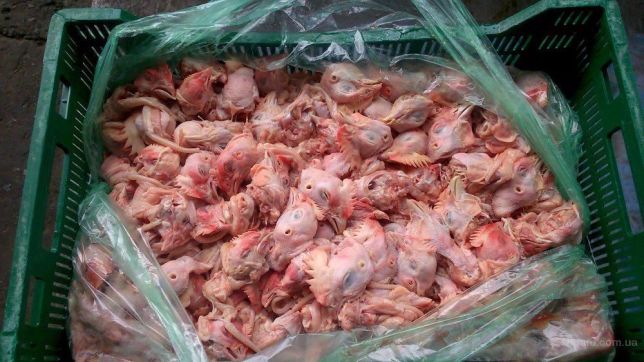

It is permissible to use both meat and fish waste when feeding a pig, but in limited quantities
Milk and dairy products
Contrary to popular belief, milk can be included in the diet of not only suckling pigs, but also fattening young. Regardless of the age of the pig, milk does not cause digestive problems for it, it only improves the well-being of the animal. In addition to milk, it is also permissible to use:
- serum;
- buttermilk;
- return
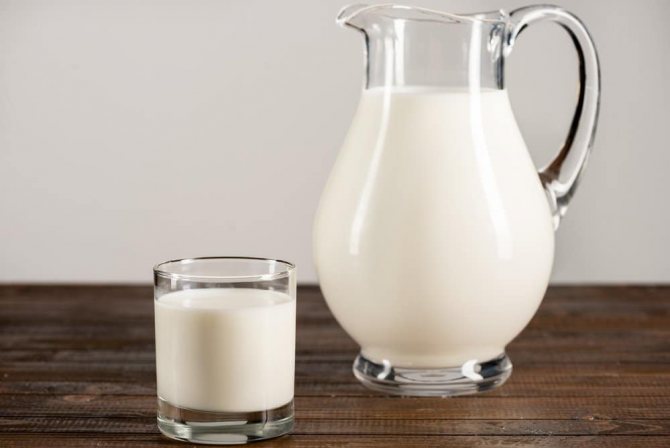

Milk can be used as an alternative to water, but you should not completely replace water
How to feed pigs for bacon
Fattening for bacon is considered a type of meat, meat pigs in the West are also often called bacon. In Russia, there has been a certain division of concepts. Bacon became known as lard with meat streaks. Meat breeds and their hybrids are also chosen for bacon. Meat piglets can sometimes be used if the breed is not very obese. In Russia, most often and for these purposes, they prefer to choose a large white breed.
Feed gains for bacon can be even higher than for meat. It is not without reason that it is considered intense. But the weight gains increase when gaining fat, not meat. Fattening for bacon is considered the most profitable with a daily weight gain of 600-700 g.
Piglets are selected more strictly for bacon than for meat. The piglet should have a long body and an even bottom line. No sagging belly. For bacon feeding, pigs are preferred, as they produce less bacon than boletus. Piglets are put on fattening from 3 months of age, after reaching a weight of 30 kg.
Animals not suitable for bacon production:
- older age;
- pregnant or overgrown sows;
- uncastrated boars;
- boletus castrated after 4 months of age;
- late maturing breeds;
- pigs with traces of trauma;
- animals with signs of disease.
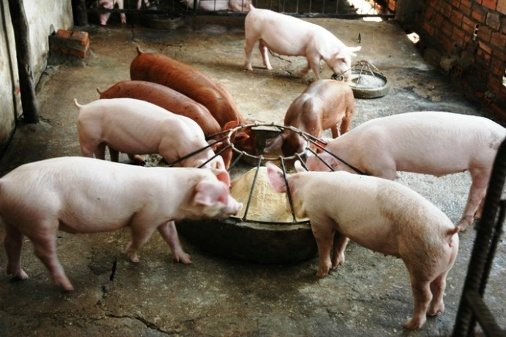

Features of feeding and maintenance
Pigs gain fat from a quiet lifestyle and feeding with carbohydrates with a high energy value. Meat grows with a lot of movement and protein-containing feed. It is not enough to feed the pig so that the lard is with layers of meat. She also needs to be forced to move during that period of time when she should build up meat. That is, they combine 2 factors: feed and lifestyle.
Important! Some craftsmen can even "make" a predetermined number of layers of meat.
But for this, in the "greasy" period, it is necessary to provide the pig with a quiet life in the barn, and in the "meat" period to make it walk. The ideal option at this moment would be to "walk" the animal to a distant pasture.
In other words, "convenient" keeping the pig in the barn and giving it feed is not suitable here. If we are talking about bacon in the foreign sense of the word, that is, about pork cut from the ribs, then everything is simpler. Most often, for these purposes, they take all the same meat breed and put it on more intensive fattening than when receiving meat.
3-month-old piglets are first fed in the same way as for meat, receiving 500 g of daily weight gain. In the second half, they are transferred to fattening with a daily weight gain of 600-700 g.
Important! You can also feed Vietnamese pot-bellied pigs for bacon, but the weight and size of such a pig will be less.
Feeding rations
At the first stage, you can use the rations developed for meat products. From the second, protein feeds are halved against the meat-based feeding option. Conversely, the proportion of cereal concentrates should be higher than when feeding for meat. From the second half of fattening, pigs can be fed with fodder pumpkin, which helps to gain fat.
For the first two months, pigs can be fed with low-cost, high-protein feeds:
- oats;
- bran;
- cake.
These feeds have a negative effect on the final product, but at the first stage it does not matter.From the second period, cheap feed is removed and pigs are switched to barley, peas and rye. You can also give millet, but it will come out more expensive.
Another option for a more detailed feeding ration for bacon, in which feed of animal origin is completely removed at the last stage.


The final stage
As in the case of fattening meat, in the last month before slaughter, all feeds that worsen the quality of products are excluded from the diet. In general, pigs are fed for bacon in the same way as for meat. All pigs are prone to mourning. Feeding for the meat on the ribs produces the same bacon, but with a thinner layer of bacon. Moreover, the thickness of the bacon often depends on the individual characteristics of the pig.
Bacon piglets are fed for about 6 months. At the end of fattening, the piglet should weigh 80-100 kg.
Which breed is better
To organize a home farm, you need not only to study and comply with the conditions for breeding pigs, but also to buy suitable livestock. All domestic pigs are divided into three categories, depending on the meat:
- Bacon. Their meat contains the most layers of fat, but there is no layer of fat.
- Greasy meat. They have premium lard, but also eat meat.
- Meat and greasy. Mainly meat is obtained from them.
In Russia, about three dozen breeds of different categories are in demand, and among themselves they differ in terms of cultivation, meat quality and weight. When determining the breed of pigs in the backyard, be guided not by the peculiarities, but by the market demand in the region:
- Large white. This breed was brought from England, but our selectors have made a significant contribution to the current appearance of animals. Competent breeding of white pigs allows individuals to gain 100 kg of weight in 7 months, and the mass of adult boars reaches 350 kg and females up to 250 kg. The breed is classified as meat-greasy.
- In the bacon category, the most popular breed in the Russian Federation is the breed called Landrace. Animals gain a hundred kilograms in about six months, and the maximum weight is 300 kg for males and 220 for females.
- It is difficult to single out the most demanded breed among the lard-meat, since there are many of them. Among them is a large black one. Pigs gain a centner in 6-7 months, reaching a maximum weight of 310 kg for boars and 215 kg for sows.
If you are interested in raising pigs for the purpose of obtaining dietary meat, pay attention to the Pietrain breed. Such pork contains less fat, and the animals themselves do not require any special care.
Technology for fattening pigs
For fattening pigs are selected not so by breed, as by unsuitability for anything else. Usually mature sows and boars culled by age from the main livestock are fed for fat. This group also includes young, but unproductive sows. For this reason, feeding for lard begins with the weight at which meat and bacon fattening ends. That is, to fatty conditions, pigs begin to feed from 120 kg of live weight.
If initially there was a goal to get exactly fat from the pig, then for fattening to fatty conditions it is better to take the same large white from the lines prone to salting. Also get a good return from the Hungarian mangalica.
Attention! Initially, mangalitsa was taken out precisely to obtain lard.
The task of such feeding is to get the maximum amount of high-quality fat and internal fat in the shortest possible time. Feeding lasts 3 months. During this time, the pig should gain another 50-60% of its original weight. The thickness of the fat in the region of the ridge in the region of the 6-7th ribs should reach 7 cm.
Pigs are examined before fattening. The emaciated in the first month are fed like meat, bringing them back to normal condition. Further, the technology of fattening is used.
Important! The quality of meat when fattening pigs is usually poor.
Such meat is used for cooking sausages. It's too tough to be eaten as steaks and chops.
How to feed pigs
Pigs are fed 2 times a day with wet nutrient mixtures. In the first half of feeding, up to 60% of concentrates are produced. The rest is supplemented with voluminous feed:
- root crops;
- potatoes;
- silage;
- hay;
- other vegetables.
Oats, bran and cake are given in very small quantities. The need for feed units is calculated taking into account the live weight of the pig and the planned weight gain. On average, there should be almost 2 times more feed units in the diet than when fed for meat.


In the second half - the last third of the period, the proportion of concentrates when feeding is 80-90% of the total diet. Juicy feed is reduced to 10-20%. The cakes and bran are completely removed and the con groups are introduced: wheat, rye, barley, peas.
Practice shows that good results are obtained when feeding pigs:
- silage of corn cobs in milky-wax ripeness;
- shit from corn;
- potatoes.
But these products are only suitable for the first stage of feeding. It is better to feed cornmeal mixed with fresh grass or hay of legumes.
When fattening a large group of pigs for fat, not only feed is important, but also the conditions of keeping. "Greasy" pigs contain 25-30 individuals in one pen. For a private owner with a small livestock, this issue is not relevant. But even a small farmer will be forced to comply with the conditions of detention.
Features of nutrition of young animals
The most effective method of feeding for meat involves several stages. Upon reaching 4 weeks of age, the piglets are weaned from their mother. Monthly weaners at home continue to feed with cow's milk and gradually introduce wet mash. Appropriate technology allows you to get juicy meat with uniform fat layers and excellent taste of meat products.
Many novice breeders are wondering how to choose piglets for fattening when switching to dry concentrated feed. As a rule, piglets are selected 3 months of age, reaching 25 kg. At this age, the young have already formed a stomach, individuals can feed on their own.
The keeping of fattening pigs involves 2 main phases:
- active set of muscle mass;
- the growth of body fat.
For fattening gilts for meat, you need to select suitable piglets and move them to a separate, bright room. Weaker individuals are also housed separately. Weaning requires special care. During this period, babies who have not yet weaned from their mother can experience stress, therefore, a deterioration in appetite is often observed. The fattening base mostly consists of wet mash and green grass.
Due to the fact that the stomach of piglets at 3 months is not yet fully formed, the feeding technology involves adherence to the diet. Piglets are fed up to 6 times a day, gradually reducing the number of feedings with age and introducing dry concentrated feed. It is at this time that an active set of muscle mass begins, so it is important to provide the piglets with sufficient walking.
How to feed pigs for fast growth
It is beneficial for the owner that the pig grows up as quickly as possible. This is not to say that the addition of vitamin and mineral premixes accelerates the growth of pigs. But without vitamins and minerals, the development of piglets stops. Therefore, the premixes must be added for the normal growth of the pig.
Growth accelerators are antibiotics that fight against pathogenic microflora. Without gastrointestinal infections, a pig grows slightly faster than one that spends energy fighting microorganisms. When grown for sale, it is beneficial to use such bactericidal preparations. These are usually found commercially under the name “growth boosters”. One of these drugs is Etonium.
The advantages of any antibacterial drugs are that fattened pigs get sick less and gain weight better. Cons from a consumer's point of view are drugs.
Attention! When raising pigs for a tribe, it is better not to use growth accelerators.
With accelerated growth, bones and joints do not have time to form. The animal grows up disabled. But it doesn't matter for the future of meat.
Growth stimulants
Among the growth stimulants used in the fattening of piglets are vitamin, tissue, mineral preparations, as well as antibiotics. The use of these substances improves the metabolic processes and the digestion of feed, which contributes to an increase in daily growth. Also, these drugs provide additional protection against microbes, reduce the risk of developing inflammatory processes and have emulsifying properties.
Mostly, such additives enrich the diet of young animals, individuals with low rates of weight gain, as well as pigs that have recently recovered from the disease.
Usually pigs get the following list of supplements:
- Amylosubtilin GZH. The drug is highly soluble in water, increases daily growth by 15%. Feed consumption is reduced by 12%. Promotes more intensive fat deposition.
- Etonius. Weight gain up to 8%, feed costs reduction up to 7%. One animal should be given 0.5 mg of the drug per 1 kg of body weight per day. After slaughter, fat rich in fatty polyacids and more meat are obtained.
- Betazine. The substance has an anti-thyroxine effect. Also reduces feed costs while increasing daily body weight gain.
- Azobacterin. A source of nitrogenous substances and vitamin B12.
- Monosodium glutamate. Animals digest food better and assimilate useful microelements. The meat at the exit turns out to be more tasty.
- Water-soluble acids (citric, succinic, glutamic). The main effect is also to stimulate growth.
Among the antibiotics that stimulate an increase in live weight, added to the combined feed and various premixes, one can distinguish:
- grisin;
- penicillin;
- streptomycin;
- hygromycin;
- kormogrizin;
- biovit;
- flavomycin;
- icin.
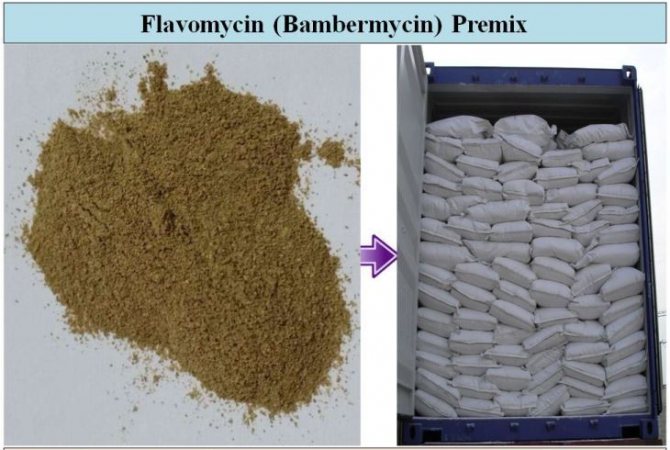

Flavomycin
Antibiotics are not only able to ensure more active growth of the animal, but also to strengthen its immunity and resistance to infectious diseases. These drugs are most effective when used together with vitamin premixes. Animals should only receive the recommended antibiotic requirements. Exceeding them can harm your herd.
The use of growth stimulants allows you to save on the purchase of feed. It also reduces the time it takes for piglets to gain weight.
Compound feed for adult pigs
Many breeders make compound feed on their own, based on the age, condition, season and the needs of specific animals. Homemade feed can be dry, crumbly, wet, mushy, thick and liquid, soup-like.
| barley | Oats | alfalfa flour | meat and bone meal | cake sunflower | a piece of chalk | salt | |
| (in d) | 400 | 300 | 160 | 120 | 80 | 20 | 10 |
And the recipe for cooking is as follows: the grain is poured into a bowl and poured with hot water, flour and cake, salt and, if necessary, premixes are added, everything is mixed and covered with burlap. The bowl is placed in a dark, warm place for 4 - 5 hours.
| pig weight (kg): | barley | wheat | corn | peas | soy meal | meat - bone flour |
| 6-9 | 33 | 23 | 14 | 15 | 9 | 3 |
| 10-20 | 33 | 23 | 19 | 10 | 9 | 3 |
| 21-45 | 35 | 20 | 23 | 12 | 5 | 3 |
| 46-100 | 45 | 35 | 10 | 5 | 2 | 3 |


Piglet feed is most often made from the following components:
- a kilogram of cereals (oats or corn, wheat, barley),
- 100 grams of feed yeast,
- 45 grams of feed fat,
- 15 - 20 grams of chalk,
- 5 grams of salt.
We suggest that you familiarize yourself with: How to feed geese properly: the right diet for diurnal, menstruation and adults
How much compound feed for pigs costs depends on the manufacturer, weight, composition and purpose. The price starts at eight rubles per kilogram. The finished compound feed contains about 12 components. The composition of a store product may vary depending on the purpose, but the basic components are the same:
- 25% - wheat,
- 20% - barley,
- 10% - oats,
- 25% - bran,
- feed flour -10%,
- the remaining 10% are premixes, salt, fiber, sodium chloride, cystine and lysine.
How to prepare combined silage
As for humans and for any animal, the monotony of food impairs appetite, which affects the effectiveness of fattening for meat. To eliminate this phenomenon, it is recommended to prepare a combined silo that includes various components. You can offer such proven recipes:
- potato tubers (4 parts), clover (3 parts), carrots without cutting the tops and cabbage leaves (1.5 parts each);
- beets (5 parts), carrots and green pulses (2 parts each), senna flour (1 part);
- corn, pumpkin, greens of legumes in a ratio of 6: 3: 1;
- boiled potatoes, a mixture of vegetable waste, grain processing waste in a ratio of 4.5: 5: 0.5;
- beets (preferably sugar), boiled potatoes, clover in a ratio of 4: 3: 3 by volume;
- a mixture of young corn cobs with carrots (4: 1).
Pig breeding can be completely mastered at home. All costs quickly pay off, and the use of effective pig feeding technologies allows you to get a lot of high-quality pork, bacon or bacon.
Calculating the profitability of pig breeding
Now let's find out if it is profitable to keep pigs for sale and how much does it cost to raise a pig? To calculate the profitability, let's take a small pig farm of 50 heads.
Each pig costs about $ 40, which means that it will take $ 2,000 in total. Each individual will need 100 kg of compound feed and 180 kg of grain annually, that is, you will spend $ 170-200 per month on feed. In part, the profitability of raising pigs depends on the quality of the feed, so do not save too much.
At first glance, the breeding of pigs as a business seems to be a very profitable business, but take into account the costs of salary to working personnel, utilities, purchase of equipment and feed, and as a result, one pig will have a net profit of 750-800 rubles per month.
With all this in mind, decide for yourself whether a pig breeding business is profitable or not.
Premixes
Premixes for pigs saturate feed mixtures with the necessary additives that increase the efficiency of feeding. The composition of the premix can contain a wide variety of minerals and amino acids, hormones and vitamins, antibiotics and enzymes that provide growth, development, and weight gain. Depending on the composition and purpose, premixes are divided into:
- mineral,
- vitamin,
- vitamin-mineral and vitamin-mineral with amino acids.
Separate premixes are produced for piglets to strengthen immunity and normalize metabolism. They allow you to accelerate the growth of young animals and improve the work of all body systems.
Determination of weight
In order to determine the weight gain of a pig over a given period of time, of course, the easiest way to weigh the animal is. However, unfortunately, it is not always possible to carry out this procedure at home. Therefore, private owners in private farms most often determine the weight gain approximately - using measurements of the chest girth and body length. In both cases, use a measuring tape. When measuring the girth of the chest, it is placed along a vertical line passing along the rear angles of the shoulder blades. Finding the length of the torso is also easy. To do this, the tape is pulled from the middle of the back of the head along the upper line of the neck, back and sacrum to the root of the tail.
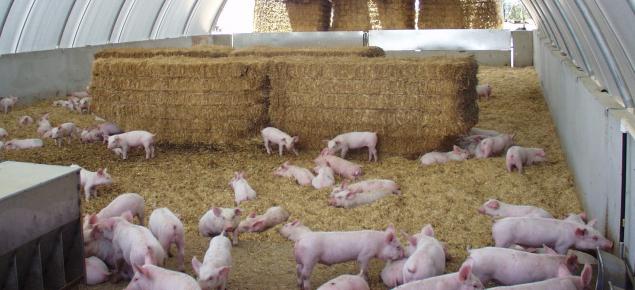

Fattening piglets for meat at home using any of the technologies described above allows you to achieve good results in live weight gain and excellent quality of the final product. With these methods, large pigs can be raised as quickly as possible.
Keeping animals for fattening
The number of animals in each group depends on what type of feeding you choose. When fattening, they usually contain about 100 pigs, bacon is more expensive, therefore it is only 50 heads, for fattening 30 heads of animals are enough.
Piglets are selected according to weight indicators. If pigs weigh up to 50 kg, then the difference between them should be no more than 5 kg, so that in the future they can grow, gaining weight equally.
Fattening meat and bacon requires spacious pigsties to have enough room for walking during the preparation period, and a closed, but not cramped room in the final. Each animal should have its own space, measuring 0.7 square meters or more.
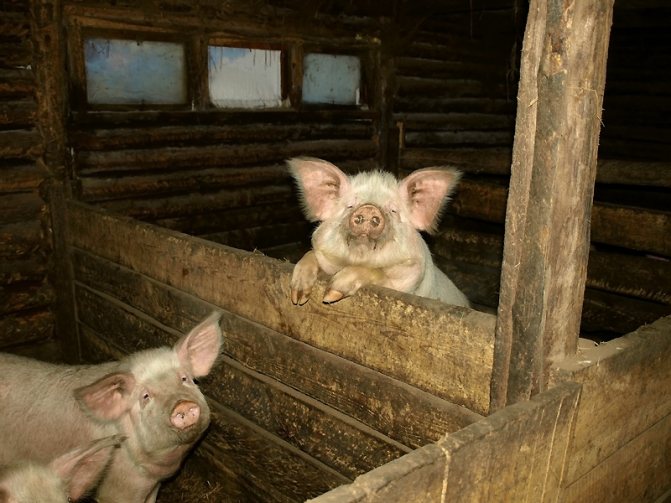

Pigsty for bacon and meat feeding
The room itself should be light and warm, if the animals are raised in winter, then a heating system must be installed in the pigsty to heat the room.
When using dry feed, especially in the summer, there must be water in the animals' drinkers at all times. The amount of water consumed by pigs per day ranges from 6 to 8 liters, depending on the period and age, the lack of fluid can negatively affect them, the animals will become lethargic and may get sick.
The containment room must have a ventilation system. If it is not possible to install special equipment in the pigsty, then it is necessary to ventilate the premises manually, for example, while walking animals.
With the right maintenance and fattening of pigs, you can learn to make a constant profit and an increase in fresh meat products that are of excellent quality and good taste.

